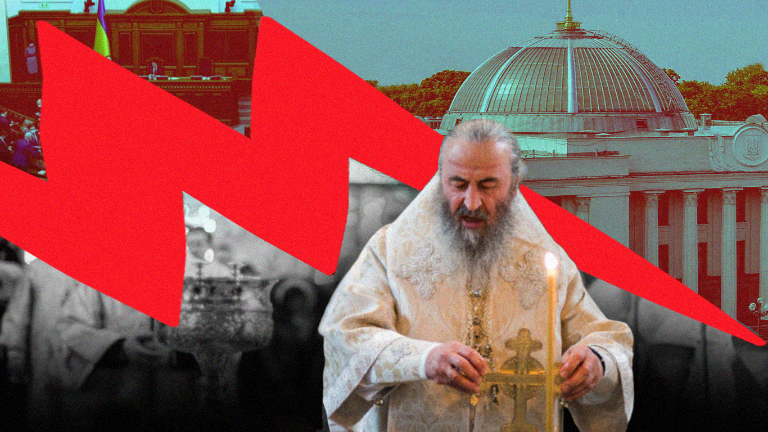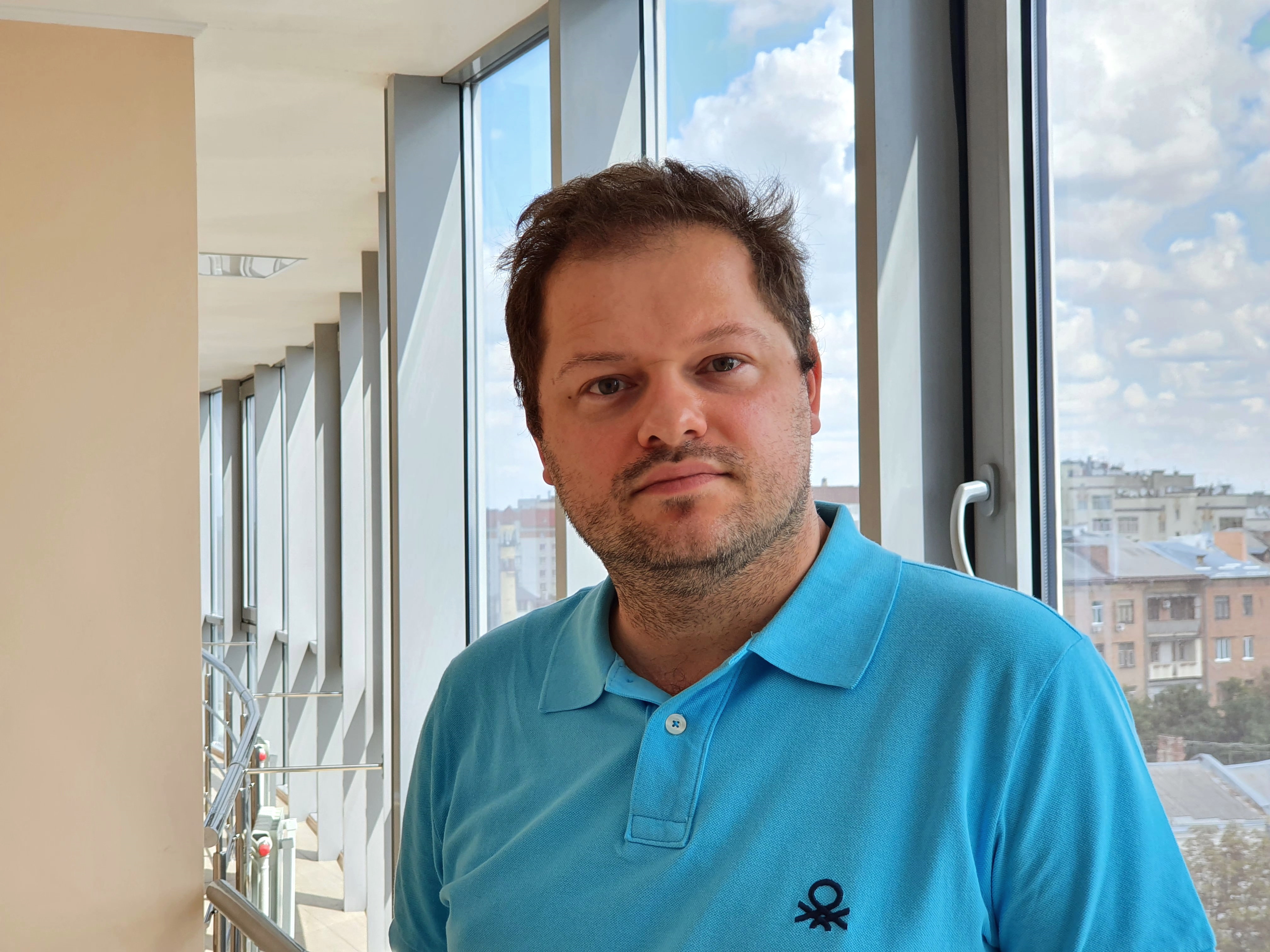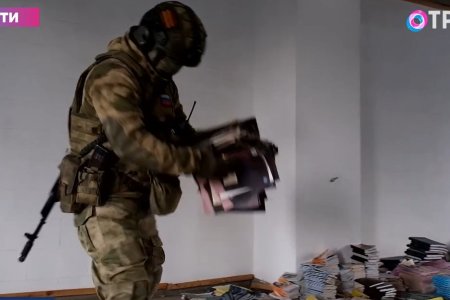
Draft Law No. 8371, “On Amendments to Certain Laws of Ukraine Regarding the Activity of Religious Organizations in Ukraine”, prohibits the activity of religious organizations with the center of influence located outside of Ukraine in the state that carries out armed aggression against Ukraine—Russia.
The Ukrainian Orthodox Church (UOC) considers the draft law to violate human rights. In the spring of 2022, it changed its own Statute, where it declared its separation from the Russian Orthodox Church. In addition, the Ukrainian Orthodox Church does not have the prefix “Moscow Patriarchate” in the register of religious organizations. Despite this, the expertise of the State Service for Ethnopolitics and Freedom of Conscience states that the UOC is still affiliated with the Russian Orthodox Church.
We spoke with Dmytro Vovk, who heads the Center for the Study of the Rule of Law and Religion, about whether it is possible to ban the Ukrainian Orthodox Church and what will happen if the draft law is adopted. KHPG has communicated with Dmytro earlier.

Can the prohibition of the entire church be justified?
When we are talking about banning not a specific religious community or organization that, for example, supported the Russian military or provided the enemy with coordinates for attacks but about the liquidation of the entire denomination, then, of course, questions of the proportionality of such a measure arise.
The Security Service of Ukraine reports 68 criminal cases, of which less than a third have been brought to court. In particular, there are verdicts against priests who were engaged in collaboration, and there are at least two cases of exchanging such priests for Ukrainian prisoners of war. But if we compare the entire Ukrainian Orthodox Church, which is historically connected to the Moscow Patriarchate —that is approximately 10,000 communities, more than 10,000 priests, and a large number of parishioners—with these 68 criminal proceedings, the response in the form of a ban on the entire organization seems disproportionate.
Moreover, this approach (banning the church as a whole) creates a problem rather than eliminates it. I don’t think banning a religious organization will make it disappear (there are plenty of historical examples of this). We will obviously get certain people who will continue to meet, pray, and maintain a particular religious life because it is important to them. It is also apparent that these communities will not dissolve into thin air; they will simply disappear from public space. Finally, how does the legal ban actually affect those priests or believers who have resorted to cooperation with the Russian military or occupation administrations? In no way, because such cases are regulated by criminal law, not the Law on Freedom of Conscience and Religious Organizations.
In addition, the discussion itself is quite politicized. I can understand this emotionally because as the war continues, cases of collaboration become known and are very painfully perceived. But if we try to move this emotional background and analyze it rationally, I would say that, in my opinion, there are not enough grounds for a complete ban. Also, the deputies who discuss it do not always understand what is being said, because one of the active sympathizers of the draft law, when asked: “Why do you ban the entire church, although there are only 68 criminal cases?” (relative to the size of the church itself, this is quite a few) answered that, if we give the appropriate powers to the law enforcement officers, then these cases will be “not 68, but 60-80 thousand, or at least 6-8 thousand in just one region” (I quote from memory). This statement is based on a rather serious misunderstanding of the area, which the parliamentarians are trying to regulate: as I said, in total, the priests of the Ukrainian Orthodox Church, which is connected to the Moscow Patriarchate, are approximately a little over 10,000 in the whole of Ukraine. In general, this discussion has already gone beyond simply discussing the problem of choosing between religious freedom and national security and establishing a balance between these spheres. It moved on to a discussion of identity, questions of whether there can be a church in Ukraine that has or had such a long relationship with Russia, and whether these priests can be allowed to operate in the religious field of Ukraine when some of them clearly have pro-Russian views or at least prefer to maintain contact with the Russian Orthodox Church, which openly supports and blesses the aggressive war against Ukraine? At the same time, many priests have an active pro-Ukrainian position; they support the military and displaced and impoverished people. It is also part of the bigger picture.
A political discussion is a totally acceptable thing. A discussion of the Ukrainian Orthodox Church in the Ukrainian state society is fully justified. Still, in my opinion, when it comes to legal solutions, a complete ban on the church will be an inadequate and, equally important, ineffective solution. The state’s policy should be more balanced and thought out.
“This discussion has already gone far beyond a simple discussion of the balance of religious freedom and national security.”
Please tell us about draft law No. 8371. How do you feel about it?
I think that this draft law is primarily a response to the request of Ukrainian society (not only its religious part) regarding the state’s response to the collaboration by the priests of the Ukrainian Orthodox Church, as well as the ambiguous attitude of this church and its leaders to the war with Russia, especially before the beginning full-scale aggression. That is, there is an expectation in society that the state will do something about it. Therefore, the President publicly announced it and then, based on the decision of the National Security and Defense Council, obliged the government to develop a corresponding draft law. According to the government’s draft law, a court order should ban religious organizations connected to centers of influence in Russia. Churches in Ukraine do not constitute a single legal entity. The Ukrainian Orthodox Church, which we are talking about because the draft law concerns it, constitutes a cloud of legal entities, where each parish, monastery, educational institution, etc., are separate legal entities. And, based on what has now been approved, first, an order on the elimination of these ties (with Russia, — ed.) is issued, and then, if they are not eliminated, the state authorities will apply to the court with a lawsuit to terminate the registration of such religious organizations.
“This draft law is a response to the request of Ukrainian society regarding the collaboration of the Ukrainian Orthodox Church priests, as well as their ambiguous attitude to the war with Russia.”
Previously, there were alternative draft laws. What are they about?
This draft law contains a relatively moderate version of the regulations because the previous ones, introduced in March 2022, provided for an automatic legal ban. According to them, all religious entities related to religious organizations in Russia should be subject to an automatic ban.
What does international law think about the prohibition of religious organizations? How can the world react to this decision?
Indeed, the issue of freedom of religion or belief is an essential issue for our international partners. This issue is fundamental to the American government because religious freedom is part of the American identity and a right that America promotes worldwide. The issue is also essential for our European partners because religious freedom is one of the fundamental human rights protected by all international treaties. When there is a question about the draft law on the complete ban of the Ukrainian Orthodox Church, I am constantly approached by international organizations and human rights defenders who start asking: “What is happening? Why does the Ukrainian government want to ban this church completely, and are there proportional grounds for this?”
International standards and best practices assume that banning a religious organization is a last resort when all other measures fail.
Based on international standards, the state should first direct its influence, particularly repressive, on the activities of specific people and, if necessary, specific communities. If a person is involved in collaborative activities, they should be held accountable. Suppose the community took part in helping the Russian military. In that case, this is a reason for the criminal responsibility of those who took part in it and the banning of this particular community. The state cannot prove that all communities were involved in such activities because, evidently, it is not the case. Whether the state will be able to prove that a significant part of the leaders of the Ukrainian Orthodox Church are involved in supporting Russia, I do not know, maybe. But then relevant evidence must be publicly provided, trials must take place, etc. In addition, in my opinion, there are no grounds for a complete ban on this church, and if the draft law is adopted in its current form, it will be subject to international criticism.
I would advise the parliament to turn to a reputable European or international institution (for example, the Venice Commission of the Council of Europe or the OSCE Bureau for Democratic Institutions and Human Rights) and ask them to provide an expert opinion on the draft law. This would significantly strengthen the legitimacy of the adopted law.
“Based on international standards, the state should direct its influence on specific people and, if necessary, a specific community.”
Can the judicial review provided for the draft law legitimize the issue of the church ban and not cause such strong criticism regarding the violation of religious freedom and human rights in the West?
International standards and best practices dictate that if you want to bana religious organization, it has the right to defend its rights in court. That is, to prove there is no reason for such a ban and to go through a proper judicial process. However, the question is, what exactly should the court consider? If the court considers the question of involving priests or believers in collaboration with Russian troops or occupation administrations, public justification of Russian aggression, or any other assistance to Russia in a situation when Ukraine is waging a defensive war for its territory, then this is one story.
If the court considers the question of whether there is a certain canonical, historical, or any other connection between this religious community and, for example, some center of influence in Russia (by which we mean the Russian Orthodox Church or persons associated with it ), and the judge makes a decision on the ban based on the existence of this connection, confirmed only by an examination that has already been carried out by the Ethnopolitics and Freedom of ConscienceState Services, to which (the examination) there are many questions, then here is an entirely different situation. That is, we proceed from the fact that the state assumes that the Ukrainian Orthodox Church and all associated entities have connections with centers of influence in Russia. This turns the process, I won’t say, into a formality, but it shifts the emphasis on what the judge must justify in a court decision.
In such a case, the liquidation of the community does not occur because its members have done something but because they have a connection that the state considers proven. Thus, they are not responsible for their actions but for belonging to the Ukrainian Orthodox Church. Based on the standards of freedom of religion or belief, believers and priests should be held accountable for their actions. For what the state considers a criminal offense, and not for the fact that they have a certain, presumed by the state, but not confirmed by illegal actions, connection with a center of influence in Russia.
This, by the way, is also an interesting point because the law does not speak about a religious organization in Russia, with which a religious organization in Ukraine must be connected, but about “centers of influence”, which is a category that can include very different subjects. Arenon-governmental organizations or mass media, for example, centers of influence? Is the educational institution in which some UOC priests lectured ten years ago such a center?
“If the court decides whether there is a canonical or other connection of a religious community with the center of influence in Russia, then the liquidation of the community does not occur because the members of the community have done something, but because they have a connection that the state considers proven.”
Are there precedents in other countries for restricting or banning religious organizations that have had ties to aggressor countries, and what have been the results?
The problem is that it applies to small religious organizations that engage in certain acts of violence and extremism, commit terrorist attacks, or infringe on the rights and freedoms of other people. An example is the infamous organization Aum Shinrikyo, which in Japan committed a terrorist attack on the Tokyo subway in the mid-90s. It was banned because the court found that not just individuals but most of the leaders of this organization were involved in planning and carrying out a terrorist attack. About a dozen people died then, although potentially thousands could have died. And in such a situation, the ban looks natural.
When we talk about the banning of such large religious organizations as the Ukrainian Orthodox Church, which has (according to various estimates) about 10,000 communities, it is difficult to find an adequate historical example. It is difficult to provide legal justification for why it is necessary to ban the entire religious organization, even when there are individual priests involved in illegal activities. It is much easier to draw parallels with a situation where there is a military or political conflict between a former metropolis and a colony, and the latter seeks to get rid of a church historically associated with the metropolis, considering it disloyal or dangerous.
There is an obvious parallel here with the former Yugoslavia. For example, the Montenegrian government is trying to limit the influence of the Serbian Orthodox Church in the country because it promotes Serbian narratives in Montenegrian society, which the government does not like. After all, Montenegro is trying to get out of Serbia’s influence.
The situation in Moldova is close to ours, where the Orthodox Church of Moldova (OCM) is part of the Russian Orthodox Church. The government of Moldova is trying to distance itself from Russia and strengthen ties with Europe. It considers the OCM an obstacle to this process and a component of Russian influence in the country. The OCM is now looking for a canonical form of how to cease being a part of the Moscow Patriarchate.
“It is difficult to provide legal justification for why it is necessary to ban an entire religious organization, even when there are individual priests involved in illegal activities.”
What are the possible consequences of adopting the law banning the Ukrainian Orthodox Church for Ukrainian society and the state?
We still do not know exactly how the state will implement this draft law, which, in my opinion, will be adopted. After all, if we are talking about 10,000 religious communities, then we will have 10,000 lawsuits. Can you imagine the amount of resources this requires? First, the state will demand to renounce ties with Russia in a format that suits the state itself and not how the church would like. Today, the Ukrainian Orthodox Church declares that they are entirely independent, not part of the Moscow Patriarchate, but apparently, this is not enough for the state. If such a termination of relations with Russia does not occur, further legal proceedings will happen. Perhaps they will be selective and will concern the Kyiv metropolis itself, certain dioceses or communities, with the understanding that the destruction of the institutional structure of the church will push parishes to change their canonical subordination, primarily by joining individual parishes to the Orthodox Church of Ukraine.
Editor: Iryna Skachko.



